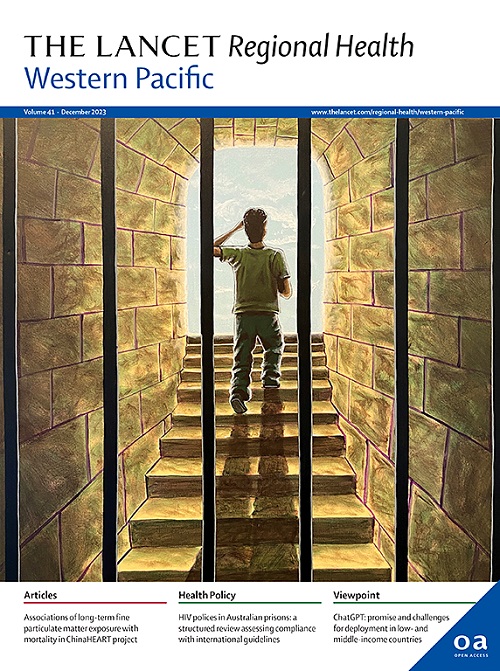Effect of aspirin on small for gestational age neonates in pregnancies at high-risk for preeclampsia: a secondary analysis of a cluster randomised clinical trial
IF 7.6
1区 医学
Q1 HEALTH CARE SCIENCES & SERVICES
引用次数: 0
Abstract
Background
Data on the effect of 100–160 mg/day aspirin prophylaxis on small for gestational age neonates (SGA) in pregnancies at high-risk for preeclampsia (PE) is limited. We aimed to determine the impact of aspirin administration on the incidence of SGA.
Methods
This is a secondary analysis of a multicenter stepped wedge cluster-randomized trial included 18 maternity/diagnostic units across ten Asian regions between 1st August 2019 and 28th February 2022. The trial started with a period where all recruiting centers provided routine antenatal care without study-related intervention. At six-week intervals, one cluster was randomized to transition from non-intervention phase to intervention phase. In the intervention phase, women identified as high-risk for preterm-PE received aspirin from <16 weeks until 36 weeks. Primary outcomes of the study were the delivery of an SGA neonate with birthweight <10th, <5th, or <3rd percentile for gestational age, adjusted for maternal weight and height, gravida, parity, ethnicity and newborn sex. The trial was registered with https://www.clinicaltrials.gov (Unique identifier: NCT03941886).
Findings
42,897/48,647 women accepted screening for preterm-PE. 10,294 (26.91%) and 27,965 (73.09%) women were included in the non-intervention and intervention phases, respectively. 2909/4688 (62.05%) high-risk women received aspirin in the trial. Pooling data from the whole trial demonstrated that aspirin was associated with increased rates of early-SGA <10th percentile (Relative risk, RR, 1.37, 95% confidence interval, CI 1.02 to 1.90). In the intervention phase, aspirin was associated with lower rates of SGA neonates with birthweight <3rd, <5th, and <10th percentile, delivered before 32 weeks (early-SGA; RR, 0.39, 95% CI: 0.20 to 0.75, 0.38, 95%CI 0.20 to 0.70, 0.41, 95%CI 0.23 to 0.74 respectively) alongside a concurrent trend indicating an increased rate of late-SGA.
Interpretation
Aspirin prophylaxis appears to be associated with a reduction in the rate of early-SGA and a simultaneous increase in the rate of late-SGA neonates born at or after 32 weeks. These findings underscore the importance of implementing the screen-and-prevent program for preterm-PE to reduce early-SGA, and emphasizing the heightened alert in follow-up to optimize the outcomes for late-SGA.
Funding
This work was supported by the National Key Research and Development Program of China from the Ministry of Science and Technology of China (MOST 2021YFC2701604) and a start up grant from the Faculty of Medicine, the Chinese University of Hong Kong.
阿司匹林对高危子痫前期妊娠中小于胎龄新生儿的影响:一项聚类随机临床试验的二次分析
背景100 - 160mg /天阿司匹林预防对高危妊娠子痫前期新生儿(SGA)影响的数据有限。我们的目的是确定阿司匹林给药对SGA发病率的影响。这是对2019年8月1日至2022年2月28日在10个亚洲地区的18个产科/诊断单位进行的一项多中心阶梯楔形集群随机试验的二次分析。试验开始时,所有招募中心都提供常规的产前护理,没有与研究相关的干预。每隔6周,一个组随机从非干预阶段过渡到干预阶段。在干预阶段,被确定为早产- pe高风险的妇女从16周到36周服用阿司匹林。该研究的主要结果是分娩一名出生体重为胎龄第10、第5或第3百分位的SGA新生儿,并根据母亲体重和身高、妊娠、胎次、种族和新生儿性别进行调整。该试验在https://www.clinicaltrials.gov注册(唯一标识符:NCT03941886)。研究结果:42,897/48,647名妇女接受了早产儿pe筛查。非干预期和干预期分别有10294例(26.91%)和27965例(73.09%)。2909/4688(62.05%)高危妇女在试验中服用阿司匹林。来自整个试验的汇总数据表明阿司匹林与早期sga的发生率增加有关(相对危险度,RR, 1.37, 95%可信区间,CI 1.02 ~ 1.90)。在干预阶段,阿司匹林与32周前分娩的出生体重为第3、第5和第10百分位的SGA新生儿的低发生率相关(早期SGA;RR, 0.39, 95%CI: 0.20 ~ 0.75, 0.38, 95%CI 0.20 ~ 0.70, 0.41, 95%CI 0.23 ~ 0.74),同时显示晚期sga发生率增加的趋势。阿司匹林预防似乎与早期sga发生率的降低有关,同时与32周或32周后出生的晚期sga发生率的增加有关。这些发现强调了对早产儿pe实施筛查和预防计划以减少早期sga的重要性,并强调了在随访中提高警惕以优化晚期sga的结果。本研究得到了中国科学技术部国家重点研发计划项目(MOST 2021YFC2701604)和香港中文大学医学院启动基金的支持。
本文章由计算机程序翻译,如有差异,请以英文原文为准。
求助全文
约1分钟内获得全文
求助全文
来源期刊

The Lancet Regional Health: Western Pacific
Medicine-Pediatrics, Perinatology and Child Health
CiteScore
8.80
自引率
2.80%
发文量
305
审稿时长
11 weeks
期刊介绍:
The Lancet Regional Health – Western Pacific, a gold open access journal, is an integral part of The Lancet's global initiative advocating for healthcare quality and access worldwide. It aims to advance clinical practice and health policy in the Western Pacific region, contributing to enhanced health outcomes. The journal publishes high-quality original research shedding light on clinical practice and health policy in the region. It also includes reviews, commentaries, and opinion pieces covering diverse regional health topics, such as infectious diseases, non-communicable diseases, child and adolescent health, maternal and reproductive health, aging health, mental health, the health workforce and systems, and health policy.
 求助内容:
求助内容: 应助结果提醒方式:
应助结果提醒方式:


